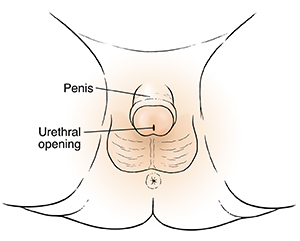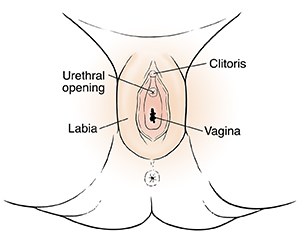When Your Child Needs Clean Intermittent Catheterization (CIC)
Children with urinary tract problems may need clean intermittent catheterization (CIC). This is the short-term (temporary) placement of a tube (catheter) to help drain the bladder. A parent or another adult does CIC until the child learns how to do it themselves. Children as young as 5 years old can do their own CICs.
How is CIC done?
CIC is done by passing a catheter into the urethra. This is the tube that carries urine from the bladder out of the body. Once the tube reaches the bladder, urine starts to drain. CIC allows the bladder to empty completely. Once the bladder is empty, the catheter is removed.
Why is CIC needed?
CIC helps your child empty their bladder. CIC done regularly also helps prevent:
Feeling nervous is normal
At first, inserting the catheter into your child’s urethra may seem scary for both you and your child. But you will have help from your child’s healthcare team. They will teach you how to do CIC. And as your child becomes more independent, they can start to help with CICs. Start by letting your child wash their hands and gather the catheter and other supplies. When your child feels ready, the healthcare provider can teach them how to do CIC.
How often is CIC done?
Do CIC as often as instructed. Don't wake your child during sleeping hours to do CIC unless you are instructed to do so. For your child, do CIC every 3 to 4 hours.
Your child’s catheter
Catheters are made of soft, flexible plastic. They come in many shapes and sizes. Some are disposable and are used once and thrown away. Others may be used multiple times if cleaned correctly. Your child’s healthcare provider will choose the best catheter for your child. If your child uses reusable catheters, ask how often they should be replaced. Follow the healthcare provider’s instructions carefully.
Using a catheter
Follow these steps when doing a CIC:
Step 1: Get ready
Step 2: Lubricate the catheter if needed
Squeeze lubricant on to a paper towel and roll the first 6 to 8 inches of the catheter in the lubricant.
Step 3: Insert the catheter
For boys:

-
Have your son stand over the toilet, sit in a chair across from the toilet, or sit upright in bed.
-
If your son is not circumcised, pull back the foreskin and keep it back during the catheterization. Clean the tip of the penis with a disposable wipe or washcloth.
-
Hold the penis on both sides, straight away from the body.
-
Gently insert the tube until urine starts to drain into the toilet. Then keep inserting the catheter about 1 inch more.
-
Hold the tube in place until the urine stops draining.
For girls:

-
Have your daughter sit on the toilet, sit in a chair across from the toilet, stand with 1 foot on the toilet rim, or lay in bed.
-
Find the 2 folds of skin that surround the vagina (called the labia). Separate them with your dominant hand. Find the urethral opening. It is located below the clitoris and above the vagina.
-
Once the urethral opening is found, clean the area with a disposable wipe or washcloth. Wipe from the urethral opening toward the vagina.
-
Keep the labia separated and gently insert the tube until urine begins to drain. Then keep inserting the catheter about 1 inch more.
-
Hold the tube in place until the urine stops draining.
Step 4: Remove the catheter
Step 5: After the CIC
-
Wipe the area between your child's legs and wash your hands.
-
If your child used a disposable catheter, throw it away.
-
If your child used a reusable catheter, wash it with soap and water, rinse it, and dry it off. Then put it into a container, such as a plastic bag that seals at the top.
-
Wash your hands with soap and warm water.
-
If your son is not circumcised, gently pull the foreskin over the tip of the penis.
Tips for successful CICs
-
Place 2 plastic bags that seal at the top in your child’s backpack. Label one “Clean” and the other “Dirty” so your child can store reusable catheters accordingly.
-
Children capable of doing so should learn to do CIC starting in kindergarten. Then your child won’t have to rely on the nurse for help with CICs.
-
Girls should not rely on mirrors to find the urethra if possible.
-
Keep in mind that your child may have some mild pain at first. This often lasts about 3 days for boys and 1 to 2 days for girls. But it depends on the child.
-
Stick closely to the catheterization schedule.
-
Make sure your child drinks plenty of liquids. Make sure they don't stop drinking liquids as a way to not have to do catheterization. The schedule needs to be followed no matter how little fluid the child drinks.
Coping
The thought of having to regularly catheterize your child can be overwhelming. You may be feeling angry or sad about your child’s need for CIC. You may view it as a loss of freedom or normalcy for your child and your family. This is to be expected. But as you begin doing CICs, you will likely become more comfortable with it. And for your child, CICs will become a normal part of their daily activities. Also keep in mind that you’re not alone. Your child’s healthcare provider will teach you how to do CICs. When your child feels ready, they will be taught how to do their own CICs. In the meantime, it’s vital for your child’s treatment and emotional development that you be supportive and patient. Encourage your child’s success by seeing to it that they follow the voiding schedule.
When to call the healthcare provider
Call your child's healthcare provider right away if your child has any of the following:
-
Fever, typically at or above 100.5 degrees, or as directed by your child's healthcare provider
-
Blood in the urine (a small trace of blood is normal)
-
Foul-smelling urine
-
Sand-like material (sediment) in the urine
-
Pain in the lower back or lower abdomen
-
Trouble inserting the catheter
-
Increased pain when inserting the catheter